Thad Allen
-
- Thad Allen at the Helm Maritime Reporter, Mar 2013 #32
Former USCG Admiral Thad Allen is a transformational leader in the history of the service, a rock through thick and thin. Today he talks about resource allocation, risk management and homeland security.
As part of Booz Allen Hamilton’s Justice and Homeland Security business group, Executive Vice President and former U.S. Coast Guard Admiral Thad Allen leads the development of thought leadership and client engagements regarding the future direction of law enforcement and homeland security. He is known for his ability to lead in a crisis, in part through his expertise in bringing together government and non-government entities to address major challenges in a “whole of government” approach designed to achieve what he calls a “a unity of effort.”
The Coast Guard is under pressure to either pare its mission mix or downscale what it does. What’s your overall take on this situation?
One of the reoccurring challenges of being in a service like the Coast Guard is that you have more authorized missions than you have resources to accomplish in a given year. I think we all understand that there won’t be large growth in those budgets unless there’s a real reason to do that. But that [brings to mind] what I call the operational genius of the Coast Guard. That means you have a multi-missioned organization, and you can apply your resources to the highest risk. The funding level will be what the funding level is, but the execution of the resources provided will always be done in an optimal fashion because the Coast Guard allows delegation of authority to regional commanders to apply resources to the highest needs. And as long as that continues to be the operational doctrine of the Coast Guard, then the American public can have the confidence that whatever the funding levels allocated, those resources will be applied according to the current set of risks. Now, that may, from time to time, be emphasizing one set of authorities or jurisdictions over another. In my view, the service has done that very well.
So how do you more with less?
Over the last I don’t know how many years, we’ve reduced our budget discussions to proverbs like “doing more with less.” There is a risk-based decision process that allows for the allocation of resources, and this drives what gets done and does not. It’s hard to predict a year in advance what the challenges to the operating environment will be. It was always a challenge when I was commandant to look at our program budget because we would keep track of our operating hours and allocate costs to those hours so that we could demonstrate the cost of a particular mission in a particular year. There was always the temptation by Congress to use that as a projecting device rather than a documentation device. So, in a constrained budget environment, you have to prioritize by risk and allocate resources accordingly. Now the risk in the Gulf of Alaska is never going to be the same as the risk in the Gulf of Mexico. These will ultimately be decisions made according to the operating environment or conditions, by people who know these conditions well.
What is the decision process for prioritizing risk?
We have a MISRAM – or a Maritime Security Risk Assessment Tool – it’s a protocol that was developed after the attacks of 9/11. I was the Atlantic Area Commander on 9/11, and we did not know what was going to happen after the attacks. We were concerned as to whether the seaports were at risk. So I took some short-term actions and deployed some Coast Guard cutters off all the major East Coast ports so that they could be a floating command and control platform and a resource for the captains of the port. But we immediately set about trying to devise a way to decide how to determine risk in ports, and how to allocate resources to that model – especially when you have a set amount of resources. And from that, we created the Port Security Risk Assessment Tool. It had a pretty indelicate acronym – everyone called it PSRAT. But, I took a bunch of my guys and I threw them in a room and said – if the Captain of the port had X amount of boat hours and X amount of flight hours and a cutter offshore and we want to make a risk-based decision, is there a more quantifiable or rational way to do that? So you do a port assessment: the waterfront facility, the refinery, is there a cruise ship there, how many pleasure boats – whatever variables exist. And then, you take a couple of scenarios like a weapon of mass effect or an IED [improvised explosive device] and then you calculate the consequences associated with that scenario. This is almost like the actuarial information used to develop insurance models. And we came up with a way to determine ratings, which would determine resource changes as a consequence of what happened with each scenario. The better question to ask then – and I’m not the best person to talk to about this right now – is, how is the Coast Guard applying MISRAM to resource allocation, especially in context to current budget discussions?
Is the pace of the regulatory development process moving fast enough?
If you look at the ballast water question, the non-tank vessel rules – which actually started around the time of the Exxon Valdez spill – nobody should be happy with the amount of time it takes to make regulations. We have gotten into a situation where the process is long and laborious, and the levels of review numerous. Now, when you are talking about five, 10, 15 years to develop a rule and deploy it as a result of a statutory requirement, I don’t think anyone should accept that that’s the right way to run government. Any way we can look at regulatory reform, we ought to be looking at it. I think we need to figure out a way to engage the public earlier - perhaps by experimenting with some sort of a wiki-platform where we could put a policy problem out there and let the supporters and detractors have at it. In this way, you can define the problem, and possibly see the consensus forming around a particular course of action before you go into rulemaking and all the Title 5 restrictions on ex-parte communications start to kick in.
What is the impact of social media, and can it be managed?
Twitter, smartphones, blogs - anything that allows people to aggregate information and produce social effects when they are not in each other’s presence – in my view have fundamentally changed our lives. I see this change as the sociological equivalent of climate change. John Holder, who was a science and technology advisor to the president, said this about climate change, “You can suffer, you can adapt, or you can manage.” The same can be said for social media. We’ve demonstrated that there is real value – and considerable risk – to crowd sourcing. It’s a new area of collaboration; a new area of social interaction where we don’t have a lot of history, and we’re really not sure where we are going. It doesn’t mean we shouldn’t use it because we’re scared of it. The fact is, it’s there, and there’s no fear of entry when an event occurs and anybody standing around with a cell phone with a camera in it can actually become part of the event or the outcome of that event. I think we have to deal with the fact that this is the reality we live in.
Are there missions the Coast Guard could cede to others in an effort to more efficiently spend money or more competently get the job done?
If we have a statutory obligation to do something, and we elect not to do it because of a risk-based decision or lack of resources, that’s one thing. But if it’s been decided for policy reasons that we shouldn’t be in line of work anymore, it might not be within our authority to make that decision. This is a tricky question because if you remember during my tenure as commandant, the Coast Guard resided inside another committee, not inside the homeland security committee. There was concern that we hadn’t been enforcing the marine safety statutes and regulations that we were provided with after 9/11, and that we might’ve been diverting resources away from those missions.’Were you enforcing maritime safety?
As commandant, I made a concerted effort to reach out to all stakeholders in the maritime community. We put resources back into the regulatory compliance functions and put into place a long-term safety and improvement plan. [Rear Admiral] Jim Watson wrote it from when he was still in the Coast Guard. And he took concrete steps to make sure we were carrying out our responsibilities.
Are there missions currently housed elsewhere that the Coast Guard could more efficiently take on?
We should talk about this in context to any capacities and capabilities that might be exploited for greater efficiencies. The current role of the Coast Guard in the intelligence community is not well understood, nor is the value demonstrated every day by what our people do in intelligence. We are a full member of the intelligence community; we have a service cryptographic element at Fort Meade. We have people that work with DoD every day, adding value. We have unique capabilities because the Coast Guard operates in places that other agencies don’t. The government would be well served to find more ways to use the unique capabilities of the Coast Guard, because there are some out there.
Is the Coast Guard now housed in the right place – DHS – or would it be better situated in another domain?
I testified repeatedly during my tenure as commandant that the Department of Homeland Security was the right place for the Coast Guard. I think you are never going to find a department that covers 100 percent of our missions, but with [DHS], we’ve come about as close as we can to covering the critical mass. That said, there’s always going to discussions about our marine safety missions, which are transportation-related. But, safety and security are two sides of the same coin; when you enhance safety, you enhance security, and vice versus.]So, I would strongly state that what don’t appear to be homeland security functions, are in fact homeland security functions. There are two issues out there right now that are continuing challenges for the department. One is general aviation aircraft and the other is unregulated small boats. I was once in a meeting with the leader of a recreational boating group and I told them that I wanted to have a serious discussion about small vessel security. I told him I was putting my toe in the water, and that I didn’t know if I was going to get bit by a piranha or a great white shark. He looked at me, and said, ‘we need to understand this: driving a car is a privilege and boating is a right.’
You have the experience of being the Coast Guard’s chief executive, and now, the luxury of looking on from the sidelines after a job well done. What has changed in the 3-plus years since you left the service?
I’m not in touch on a daily basis with what the Coast Guard has going on, so I am not in a position to say anything about what’s happened since I left. I can tell you this: the Coast Guard has made extraordinary improvements in institutionalizing its acquisition program that’s delivering vessels like the fast-response cutter and the national security cutter. When I became the commandant, I spent a great deal of my time preparing for oversight hearings related to our acquisition programs. I think the coast guard can be very proud as to where they’ve come with regard to those programs.
What’s the biggest challenge facing the Coast Guard today? Is it operational, fiscal, manpower-related – or, all of the above?
The biggest challenge for the Coast Guard – and it has been since it was created – is to develop and retain cultural and organizational competencies to manage operational risk and apply those resources. That is the key element of what I call the operational genius of the Coast Guard. The only way you can run an organization as unique as the Coast Guard, and have it be as effective as it is, is to have leaders who know how to make resource allocation decisions and be held accountable for them. The enduring value of the Coast Guard is it is still able to do that. The Coast Guard is a unique product of the American Revolution. Before the Revolution, you had navies; you had border guards and police forces at harbors and things like that. The origin of the service emanates from the Founding Fathers, who realized that this was the only way with this much trade going on. Tom Ridge [first director of DHS]said, ‘If we didn’t have a Coast guard, we’d have to invent or create one.’ If you look around the world, most countries are mostly interested in what happens in their littoral waters, about their natural resources, issues about illegal fishing, drug trafficking, offshore oil development, etc. All of those mission sets call for a maritime constabulary force that is much more adaptable across those ranges of threats. The key is to reconcile the security demands for a navy and the local law enforcement missions. We’ve been able to do that in this country.
Looking back on your service – what part of it are you the most proud?
If you look back at the advances that have been made in the finance and acquisition areas, and the extraordinary advances in how we manage lifecycle sustainment assets, and how we’ve reformed our supply chain management and maintain our operating platforms, these are fundamental business re-engineering activities that we probably won’t know the results of for many years. A great legacy would be to be able to say we fundamentally changed how we do things inside the Coast Guard, and for the better. These aren’t things that are generally seen by the public.
Conversely, where do you wish you could have accomplished more or something a little bit differently?
I wish I could’ve speeded up the regulatory process. I talked to everyone I could about this issue, but unless there is a national will to do something about it, it likely isn’t going to happen. I was continually frustrated with the regulatory process.Anatomy of a Leader Thad William Allen
Born
Jan. 16, 1949, in Los Angeles; grew up in Tucson, Ariz.
Education
Graduated 1971 from the Coast Guard Academy, an institution Sen. John McCain joked was one that “some might say he foolishly chose over an appointment to the Naval Academy.” (Allen’s father was a Chief Damage Control man in the Coast Guard.) Two advanced degrees: Masters in Public Administration, George Washington University, 1986; and Masters of Science in Management at MIT’s Sloan School, 1989.
Coast Guard Career
Held a variety of posts ranging from ship master to commander of various USCG regional and coastal groups, to posts in the office of acquisitions, office of programs, and office of chief of staff, eventually becoming chief of staff to the commandant.
Critical Operational Missions
Command of the Coast Guard’s Atlantic forces in its response to the Sept. 11, 2001 terrorist attacks by securing ports on the eastern seaboard. Appointed Principal Federal Officer for Hurricane Katrina and Rita recovery efforts in the Gulf Coast region in 2005. Commandant of team leading response to Haiti earthquake in January 2010. Allen was also the commandant leading the response Appointed National Incident Commander for the Deepwater Horizon oil spill in the Gulf of Mexico in 2010 while still commandant of the USCG. He continued in that role after his retirement from the Coast Guard.
Homeland Security
Worked closely with the Department of Homeland Security, advancing much-needed operations and management coordination principles. Recognized as a leader in homeland security strategy, with particular emphasis on achieving interagency unity of effort in the complex, multi-agency and multi-jurisdictional homeland security and law enforcement mission environment. Chairman of the DHS Joint Requirements Council from 2003 to 2006.
Appointed
A four-star admiral, he became the 23rd Commandant of the U.S. Coast Guard on May 25th, 2006, where he was known both as “the Face of the Coast Guard” and as a forward thinking leader who led a major effort to update the Coast Guard’s command and logistics organizations and address future maritime challenges. As commandant, Allen oversaw a mix of 90,000 active-duty military, civilian staffers, reservists and volunteer auxiliaries.
Retired: In May 2010, after 38 years with the Coast Guard. Post retirement, continued to serve as the National Incident Commander for the Deepwater Horizon oil spill as a member of the Senior Executive Service within DHS.
Military Decorations
Two Coast Guard Distinguished Service Medals; the Legion of Merit, which is awarded by the U.S. Armed forces for exceptionally meritorious conduct in the performance of outstanding services and achievements; the Defense Distinguished Service Medal, three Meritorious Service Medals, three Coast Guard Commendation Medals and two Coast Guard Achievement Medals.
Civilian Awards
Among his many personal awards, Admiral Allen was the first recipient of the Homeland Security Distinguished Service Medal, of which he has two; Organized Crime Drug Enforcement Task Force National Award, Operation Panama Express, 2001, and was named to Time magazine’s 2010 Person of the Year issue’s list of “People Who Mattered.”
Boards and Organizations
Allen serves as a Presidential appointee on the NSF’s Blue Ribbon panel on Antarctica, as a Director at the Partnership for Public Service and the CG Foundation, and at the U.S. Naval Institute, 1974-Present. He was on the Board of Trustees, U.S. Coast Guard Academy, 1996-1999.
Current post
Joined Booz-Allen Hamilton in November 2011 as Senior Vice President leading “thought leadership” on law enforcement and homeland security strategy. Allen previously joined RAND Corp. as a senior fellow in Oct. 2010, where he focused on myriad of disaster response, maritime safety and homeland security issues.
Noteable Quote
“The modernization and strategic transformation the Coast Guard is undertaking is about looking into the future and repositioning the Service to best serve the Nation far into the 21st Century.”
Management mantras: “You have to lead from everywhere” (Harvard Business Review, Nov. 2010)Quintessential Allen
A selection of quotes from former U.S. Coast Guard Commandant (2005-2009) and disaster manager extraordinaire Thad Allen:
About being “the government face of the [Deepwater] tragedy:
“I told somebody I’m failing to get fired. I’m honored to have been asked to do this. It’s not a very easy job; it’s very complex. It’s one of the hardest things I’ve ever had to deal with personally.”
Source: Associated Press interview, June 7, 2010
About the government’s response to Hurricane Katrina:
The problem with the government’s initial response to Hurricane Katrina was that “we did not get the problem statement right.” The government thought the problem was a hurricane when it had become a flood. “You’ve got to understand the problem first before you can effectively lead change.’’
Allen speaking to the Association of Change Management
Professionals conference in May, 2011
Testimony from Allen during his Congressional confirmation hearings
“While the character and nature of our service are clear, our missions are not static. New threats emerge as others are mitigated, and Coast Guard capabilities, competencies, organizational structure, and processes must change accordingly. If confirmed, my enduring goal will be to lead a Coast Guard that is steadfast in its character but adaptive in its methods.”
How to deal with a complex, fast moving crisis, where , unlike a tactical military campaign, you won’t have unity of command.:
“In what I would call a ‘whole of government response’ —to a hurricane, an oil spill, no matter what it is—that chain of command doesn’t exist. You have to aggregate everybody’s capabilities to achieve a single purpose, taking into account the fact that they have distinct authorities and responsibilities. That’s creating unity of effort . . . and it’s a much more complex management challenge.”
The impact of social media and the 24-hour news cycle:
“We all have to understand that there will never again be a major event in this country that won’t involve public participation. And the public participation will happen whether it’s managed or not. We’ve chosen to try to adapt and manage. Before the oil spill, I had already started blogging and tweeting.”
In an interview in November 2010 with the Harvard Business
Review, Allen expounded on a number of leadership issues
Impressions of Allen from near and afar
“I note that this [nomination] is somewhat ironic, since the largest body of water in the Admiral’s hometown [Tuscon, Ariz.] is the University of Arizona’s swimming pool.” Sen. JOHN McCAIN (R), Ariz., while introducing Allen at a his March 2006 nomination hearing for the post of Coast Guard Commandant.
Allen “always brings a new idea per minute to the table as far as how to grapple with difficult situations.”
Retired Adm. James M. Loy, former Commandant of the Coast Guard
“No Coastie better demonstrated the service’s ‘get it done attitude’ better than Admiral Allen, who confidently stepped in to a critical leadership role and righted the Federal Government’s response to Katrina. His ability to coordinate the efforts of all local, state, and Federal agencies into one harmonious response should be the model to emulate when the next disaster strikes.”
Former Maine Sen. Olympia Snow (R)
“I’m confident in Admiral Allen, seeing his work in Katrina. You’ve brought the most credibility and discipline and structure and analysis to that chaos, from those of us watching all around the world.”
Former VA Sen. George Allen (R)
(As published in the March 2014 edition of Maritime Reporter & Engineering News - www.marinelink.com)
-
- The Thad Allen No-Frills Leadership Primer Maritime Reporter, Mar 2014 #37
find it a lot easier to step away from the stacks and take a page from a leader extraordinaire, retired Admiral and former Commandant of the Coast Guard, Thad Allen. If ever two phrases seemed synonymous, they are Thad Allen and crisis management, probably because Leadership – with a capital “L” – is synonymous
-
- USCG Maritime Reporter, Mar 2013 #32
Coast Guard in May of 2010, he had the unenviable task of following perhaps the most charismatic leader the Coast Guard has ever had. The high profile Thad Allen, dubbed by the mainstream media as “the rock star” Commandant, also more earned his reputation by firm leadership over the course of more than one
-
- USCG ... Past, Present & Future Maritime Reporter, Mar 2014 #6
of Maritime Reporter & Engineering News’ 75th Anniversary, Patricia Keefe takes an insightful look at the times, tribulations, leadership and legacy of Thad Allen, past Commandant of the U.S. Coast Guard. Allen is widely considered to be one of the transformational leaders in this position of all time, and
-
- Protection Zones In Place For USS Roosevelt's Return Maritime Reporter, Apr 2002 #19
with the NVPZ restrictions and comply with all orders directed by the Coast Guard and Navy patrols. Coast Guard Atlantic Area Commander Vice. Adm. Thad Allen established the Naval Vessel Protection Zone regulation effective from Sept. 14, 2001 to June 15, 2002, providing another safety measure for
-
- Ballast Water Leadership Maritime Reporter, Aug 2014 #28
United States has been blessed with strong Coast Guard Commandants. Around the Gulf of Mexico, for instance, the quiet, serious demeanor of Admiral Thad Allen was crucial to recovery from Hurricane Katrina and efforts to end the BP Macondo oil well disaster. If anyone ever deserved a Congressional gold
-
- Admiral Schultz Emphasizes Maritime as a Driver of U.S. Commerce Maritime Reporter, Jul 2019 #36
. It’s having capable leadership across the regions. We put empowered leaders in the field that build collaborative relationships in the field. As Thad Allen said, ‘we must be jurisdictionally multilingual,’ meaning we are able to talk the National Security Agency (NSA) as easily as we do the local sheriff
-
- New Tech & Tug Training Marine News, Jan 2014 #36
of a scenario that comes from working on and with full-size vessels, said 2C Cadet Berendes. As noted by former U.S. Coast Guard Commandant Admiral Thad Allen, while giving the commencement address at MMA’s 2012 graduation, “Leaders are lifelong learners.” In short, simulation today, simulation forever
-
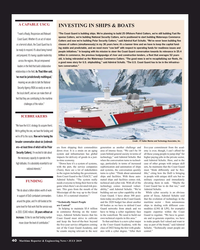 )
July 2019 - Maritime Reporter and Engineering News page: 40
)
July 2019 - Maritime Reporter and Engineering News page: 40. “The U.S. Coast Guard has to be in the infrastruc- ture conversation.” leaders in the ? eld that build collaborative relationships in the ? eld. As Thad Allen said, ‘we must be jurisdictionally multilingual,’ meaning we are able to talk the National Security Agency (NSA) as easily as we do the local
-
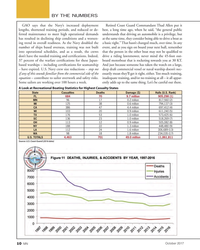 )
October 2017 - Marine News page: 10
)
October 2017 - Marine News page: 10BY THE NUMBERS GAO says that the Navy’s increased deployment Retired Coast Guard Commandant Thad Allen put it lengths, shortened training periods, and reduced or de- best, a long time ago, when he said, “the general public ferred maintenance to meet high operational demands understands that driving an
-
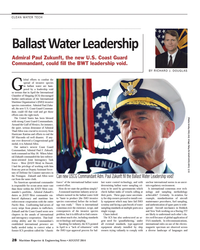 )
August 2014 - Maritime Reporter and Engineering News page: 28
)
August 2014 - Maritime Reporter and Engineering News page: 28United States has been blessed with strong Coast Guard Commandants. Around the Gulf of Mexico, for instance, the quiet, serious demeanor of Admiral Thad Allen was crucial to recovery from Hurricane Katrina and efforts to end the BP Macondo oil well disaster. If any- one ever deserved a Congressional
-
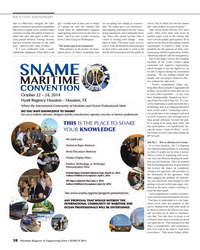 )
March 2014 - Maritime Reporter and Engineering News page: 38
)
March 2014 - Maritime Reporter and Engineering News page: 38factions, and get everyone focused on the same goal – what he calls “unity of effort.” “If I was confronted with a multi- stakeholder nightmare, Thad Allen is the guy I would want to have put in charge of coming up with the solution that would keep the stakeholders engaged, participating and
-
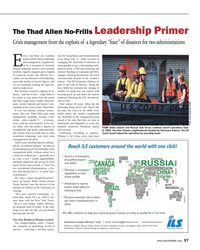 )
March 2014 - Maritime Reporter and Engineering News page: 37
)
March 2014 - Maritime Reporter and Engineering News page: 37lot easier to step away from the stacks and take a page from a leader extraordi- naire, retired Admiral and former Com- mandant of the Coast Guard, Thad Allen. If ever two phrases seemed synony- mous, they are Thad Allen and crisis management, probably because Lead- ership – with a capital “L” – is
-
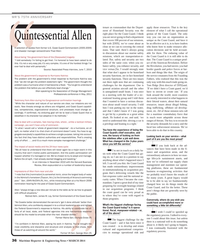 )
March 2014 - Maritime Reporter and Engineering News page: 36
)
March 2014 - Maritime Reporter and Engineering News page: 36process. Quintessential Allen A selection of quotes from former U.S. Coast Guard Commandant (2005-2009) and disaster manager extraordinaire Thad Allen: About being “the government face of the [Deepwater] tragedy: “I told somebody I’m failing to get fi red. I’m honored to have been asked to do
-
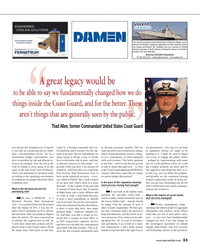 )
March 2014 - Maritime Reporter and Engineering News page: 33
)
March 2014 - Maritime Reporter and Engineering News page: 33say we fundamentally changed how we do things inside the Coast Guard, and for the better. These aren’t things that are generally seen by the public. Thad Allen, former Commandant United States Coast Guard USCG MR #3 (32-41).indd 33 3/4/2014 10:50:50 AM
-
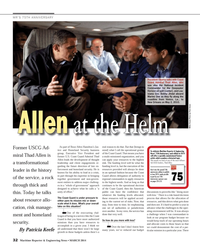 )
March 2014 - Maritime Reporter and Engineering News page: 32
)
March 2014 - Maritime Reporter and Engineering News page: 32offer a specially commissioned feature article which examines a historical topic. This month we look at one of the most infl uen- tial USCG leaders, Thad Allen Don’t miss the special 75th anniversary edition to publish in June 2014, made possible in part by our 75th Anniversary sponsors seen on pages
-
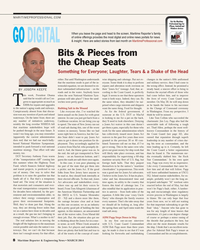 )
March 2014 - Maritime Reporter and Engineering News page: 8
)
March 2014 - Maritime Reporter and Engineering News page: 8, I think he will be missed. Like Tom Collins who succeeded the charismatic Jim Loy, Papp also had the unenviable task of following a tough act. Thad Allen, perhaps the most well- known Commandant in the history of the Coast Guard (see page 32), also earned that reputation through superb leadership
-
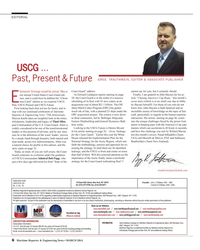 )
March 2014 - Maritime Reporter and Engineering News page: 6
)
March 2014 - Maritime Reporter and Engineering News page: 6Reporter & Engineering News’ 75th Anniversary, Patricia Keefe takes an insightful look at the times, tribulations, leadership and legacy of Thad Allen, past Commandant of the U.S. Coast Guard. Allen is widely considered to be one of the transformational leaders in this position of all time
-
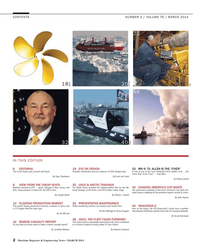 )
March 2014 - Maritime Reporter and Engineering News page: 2
)
March 2014 - Maritime Reporter and Engineering News page: 2. By Edward Lundquist 32 MR @ 75: ALLEN IS THE “FIXER” A look at one of the most infl uential USCG leaders ever ... the “Rock Star” & the “Fixer” ... Thad Allen. By Patricia Keefe 40 CHASING AMERICA’S CUP BOATS The speed and complexity of last year’s America’s Cup boats pro- vided serious challenge for
-
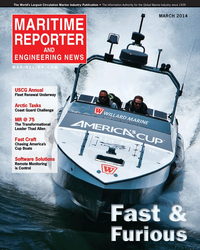 )
March 2014 - Maritime Reporter and Engineering News page: Cover
)
March 2014 - Maritime Reporter and Engineering News page: Coversince 1939 AND ENGINEERING NEWS USCG Annual Fleet Renewal Underway Arctic Tasks Coast Guard Challenge MR @ 75 The Transformational Leader Thad Allen Fast Craft Chasing America’s Cup Boats Software Solutions Remote Monitoring is Control M A R I N E L I N K . C O M MARCH 2014 COV1 MR
-
 )
April 2002 - Maritime Reporter and Engineering News page: 17
)
April 2002 - Maritime Reporter and Engineering News page: 17the NVPZ restrictions and comply with all orders directed by the Coast Guard and Navy patrols. Coast Guard Atlantic Area Comman- der Vice. Adm. Thad Allen established the Naval Vessel Protection Zone regula- tion effective from Sept. 14, 2001 to June 15, 2002, providing another safety measure
-
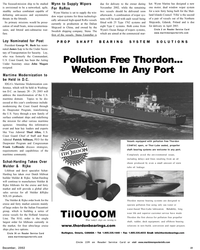 )
December 2002 - Maritime Reporter and Engineering News page: 33
)
December 2002 - Maritime Reporter and Engineering News page: 33redefining the mission for other various maritime agencies Attending this informative event and hear key leaders and experts like Vice Admiral Thad Allen, U.S. Coast Guard Chief of Staff and Rear Admiral Patrick Stillman, PEO for the Deepwater Program and Congressman Frank LoBiondo discuss
-
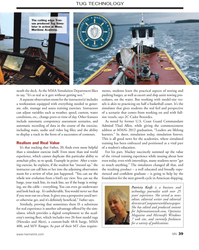 )
January 2014 - Marine News page: 39
)
January 2014 - Marine News page: 39a scenario that comes from working on and with full- size vessels, says 2C Cadet Berendes. As noted by former U.S. Coast Guard Commandant Admiral Thad Allen, while giving the commencement address at MMA’s 2012 graduation, “Leaders are lifelong learners.” In short, simulation today, simulation forever
-
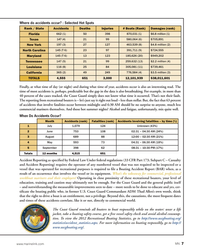 )
June 2013 - Marine News page: 7
)
June 2013 - Marine News page: 7improvements seen to date ? more needs to be done to educate and yes, cer- ti cate the boating public who, in former U.S. Coast Guard Commandant ADM Thad Allen?s own words, think that the right to drive a boat is an entitlement, not a privilege. Beyond this, the causations, the most frequent dates and
-
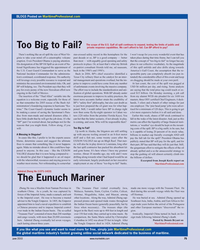 )
June 2, 2010 - Maritime Reporter and Engineering News page: 75
)
June 2, 2010 - Maritime Reporter and Engineering News page: 75, too. The President says that they will pay for every penny of the now Herculean effort now ongoing in the Gulf of Mexico. The insertion of the “Thad Allen” variable into the equation is a welcome event, especially for those of us that remember his 2005 rescue of the Bush Ad- ministration’s foundering
-
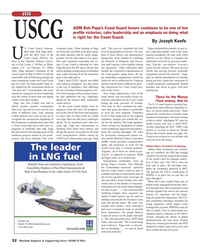 )
March 2013 - Maritime Reporter and Engineering News page: 32
)
March 2013 - Maritime Reporter and Engineering News page: 32the Coast Guard in May of 2010, he had the unenviable task of following perhaps the most charismatic leader the Coast Guard has ever had. The high pro Þ le Thad Al- len, dubbed by the mainstream media as ?the rock star? Commandant, also more earned his reputation by Þ rm leadership over the course of more than
-
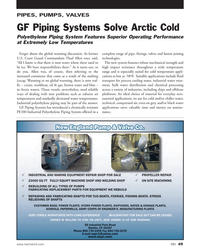 )
May 2012 - Marine News page: 50
)
May 2012 - Marine News page: 50www.marinelink.com MN49PIPES, PUMPS, VALVES Forget about the global warming discussion. As former U.S. Coast Guard Commandant Thad Allen once said, ?All I know is that there is now water where there used to be ice. We have responsibilities there.? As it turns out, so do you. Allen was, of course, then
-
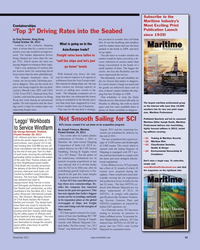 )
November 2011 - Maritime Reporter and Engineering News page: 91
)
November 2011 - Maritime Reporter and Engineering News page: 91.com SETTING UP SHOPIN BRAZILPAGE 38 CLASS HELPS TO MITIGATE RISK PAGE 30 NEW RULES FORSALVAGE & FiFi PAGE 28 DRYSHIPS: TO THEABYSS & BACK?PAGE 44 THAD ALLEN& THE ART OF CRISISMANAGEMENT PAGE 22 MaritimeProfessional Training & EducationGMATS TAKES MARPRO TO SCHOOL MEET SUZ MICHEL, CROWLEYS NEW VP OF
-
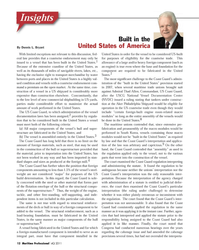 )
Q4 2011 - Maritime Logistics Professional page: 12
)
Q4 2011 - Maritime Logistics Professional page: 12Guard?s admin- istration of the ?built in the United States? provision started in 2007, when several maritime trade unions brought suit against Admiral Thad Allen, Commandant, US Coast Guard, after the USCG National Vessel Documentation Center (NVDC) issued a ruling stating that tankers under construc- tion
-
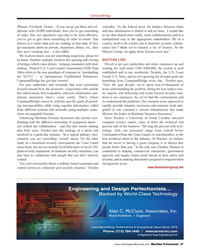 )
Q3 2011 - Maritime Logistics Professional page: 37
)
Q3 2011 - Maritime Logistics Professional page: 37example involves the opening and closing of bridges which cause delays ? helping commuters with theirrouting.? Retired U.S. Coast Guard Commandant ADM Thad Allen refers to the new paradigm of response as ?marshalling the SUV?s? ? or Spontaneous Unaffiliated Volunteers. CommandBridge has got that covered. For
-
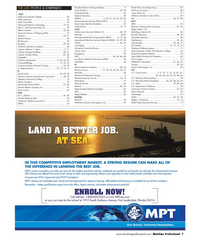 )
Q3 2011 - Maritime Logistics Professional page: 7
)
Q3 2011 - Maritime Logistics Professional page: 7University College............................................30 ADM James Loy.............................................................34 ADM Thad Allen............................................................37 Advanced Detection Technology................................19, 41 Alan C. McClure
-
 )
May 2011 - Maritime Reporter and Engineering News page: 16
)
May 2011 - Maritime Reporter and Engineering News page: 16the Author Dennis L. Bryant, Maritime Regulatory Consulting, Gainesville, FL Tel: 352-692-5493 Email: [email protected] Retired USCG Adm. Thad Allen, na- tional incident commander for the Deepwater Horizon oil spill response, along with Frederick Lemond Jr., Venice Branch BP supervisor, and
